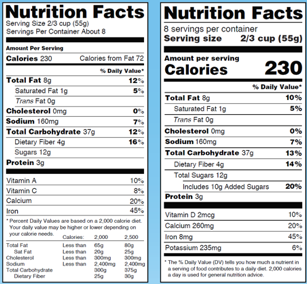As food regulatory attorneys, we become somewhat excited when the U.S. Food and Drug Administration (FDA) or the U.S. Department of Agriculture (USDA) issues a new law or policy; we think about how it affects our clients and whether the new law or policy truly promotes the public good. What we often notice, however, is that implementation of such rule or policies often becomes delayed, or an extra grace period is provided for the companies to comply. For example, FDA recently announced that it will not require compliance with the new 2016 nutrition labeling rule until July 1, 2020 for certain companies.[1] Similarly, USDA is also providing a buffer period for enforcement for the bioengineering disclosure rule until January 1, 2022, although the official effective date of the rule is January 1, 2020. Such enforcement discretion or buffer periods can be helpful in ensuring that the changes in laws do not affect business negatively. We have been receiving many questions about these laws and regulations recently. Although the agencies may delay enforcement again, we wanted to take this opportunity (and the extra time) to address a few questions regarding the new upcoming FDA and USDA labeling regulations.
First, the question that we probably receive the most often is: which party is ultimately responsible for ensuring compliance with the new regulations? The modern food supply chain is complex. The majority of food and food ingredients are imported from overseas, sometimes processed in the United States (oftentimes by contract manufacturers), at times repackaged by third-party distributors, and only then finally marketed to the public. This complex supply chain means that deciding who is responsible for regulatory compliance can be difficult because so many parties are involved in the process. The short answer to this question is that theoretically, any party that is responsible for introducing the food into interstate commerce is responsible for correct labeling. This is because federal law[2] prohibits sales, marketing, or distribution of any products that violate the Federal Food, Drug, and Cosmetic Act or its implementing regulations.
In practice, however, FDA is likely to consider certain parties to be more responsible for compliance than others. In fact, FDA mentions some of these examples in its guidance.[3] For example, FDA may consider a private label distributor to be more responsible than the contract manufacturer for labeling compliance because the private label distributor is directly responsible for introducing the product to consumers. On the other hand, FDA states that the supplier of a food ingredient is responsible for the accuracy of the information it provides to the processor if there is no suitable way for the processor to determine nutrient values; this is because here, the supplier is the one that can ensure compliance. While the answer to the question of who is responsible will differ in every case, a good way of solving this issue in advance is to delineate in the contract the regulatory obligations of each party (e.g., label review before the final release of the product). This will help ensure regulatory compliance and in the unfortunate event that any noncompliance is found, the parties will able to resolve the disputes more effectively, hopefully without resorting to costly and lengthy dispute resolution mechanisms.
 In addition, we often hear about what exact changes were made to the nutrition labeling rule. FDA made several key changes to nutrition labeling. Importantly, FDA instituted a new requirement for Added Sugars—sugars that are added during processing of the food. This is applicable to many types of sugars, including syrups and honey, certain concentrated fruit or vegetable juices, and free-, mono-, or disaccharide forms of sugars (for general changes to the format, please refer to the graphic below graphic from FDA; on the left is the old panel, and on the right is the new panel). Importantly, what many industry members overlook is that the new rule includes record-keeping requirements. For example, records must be kept for 2 years to support the declaration of dietary fiber in the product. Similarly, manufacturers must keep a record of the amount of added sugars in foods that may go through nonenzymatic browning or fermentation, because it may not be technologically possible to distinguish between naturally occurring sugars and added sugars in such circumstances. This may be a particularly important change both from regulatory and consumer litigation perspectives, given that plaintiffs’ attorneys regularly scrutinize the food labels for any potential sources of lawsuits.
In addition, we often hear about what exact changes were made to the nutrition labeling rule. FDA made several key changes to nutrition labeling. Importantly, FDA instituted a new requirement for Added Sugars—sugars that are added during processing of the food. This is applicable to many types of sugars, including syrups and honey, certain concentrated fruit or vegetable juices, and free-, mono-, or disaccharide forms of sugars (for general changes to the format, please refer to the graphic below graphic from FDA; on the left is the old panel, and on the right is the new panel). Importantly, what many industry members overlook is that the new rule includes record-keeping requirements. For example, records must be kept for 2 years to support the declaration of dietary fiber in the product. Similarly, manufacturers must keep a record of the amount of added sugars in foods that may go through nonenzymatic browning or fermentation, because it may not be technologically possible to distinguish between naturally occurring sugars and added sugars in such circumstances. This may be a particularly important change both from regulatory and consumer litigation perspectives, given that plaintiffs’ attorneys regularly scrutinize the food labels for any potential sources of lawsuits.
Lastly, although not an FDA requirement, while we’re on the subject of labeling changes, we would like to note that a new USDA bioengineering labeling requirement will become effective on January 1, 2020,[4] although the agency will not enforce until January 1, 2022. While this might seem far away, the bioengineering disclosure rule may require changes to the product formulations or the supply chain. In short, the USDA’s bioengineering labeling rule requires disclosure on whether a product contains detectable genetic materials that have been modified in labs and not found in the nature (i.e., genetic engineering). While certain exemptions exist (e.g., foods subject to the USDA labeling jurisdiction with the predominant ingredient also regulated by the USDA; incidental additives), generally speaking, food containing genetically engineered ingredients will need to disclose such inclusion through graphic or textual messages (e.g., “bioengineered food,” “contains a bioengineered food ingredient,” or a symbol). Interestingly, the USDA stated that although the “implementation date is January 1, 2020,” the agency will begin enforcement on January 1, 2022. While some time remains, companies will want to review this quickly to determine the proper marketing and regulatory strategy given that this may result in formulation changes.
In sum, there is likely to be a sea change in the regulatory environment for food manufacturers, distributors, and marketers because of the new FDA labeling regulations and USDA disclosure rules coming into effect beginning in 2020 through 2022. We understand first-hand from working with our clients how much time, money, and effort it can take to update the labels. While such changes may be challenging at first, manufacturers, distributors, or marketers that embrace and prepare for the changes in advance will be able to minimize the risk of regulatory enforcement and focus their energy on building their business. We would like to invite you to review these rules closely, and begin the preparation. If you have any questions, please do not hesitate to reach out to us.
Cori Annapolen Goldberg, a partner in the ReedSmith Life Sciences Health Industry Group, focuses her practice on FDA regulatory issues for the food, drug, medical device and cosmetic industries across the supply chain, including companies investing in these industries.
Sung W. Park is an associate in the Life Sciences Health Industry Group in the Washington D.C. office. His practice focuses on providing regulatory counsel to companies developing, distributing, and marketing FDA-regulated products, and responding to regulatory and administrative enforcement actions by federal and state agencies such as FDA, USDA, and state Attorneys General offices.
References
1. www.fda.gov/food/food-labeling-nutrition/industry-resources-changes-nutrition-facts-label#Compliance .
2. The Federal Food, Drug and Cosmetic Act. 21 U.S.C. 301(a).
3. FDA Guidance to the Industry, Nutrition and Supplement Facts Labels: Questions and Answers Related to the Compliance Date, Added Sugars, and Declaration of Quantitative Amounts of Vitamins and Minerals: Guidance for Industry (November 2018).
4. For certain small food manufacturers, the effective date is January 1, 2021.
FDA’s and USDA’s Upcoming New Regulations and the Delays




